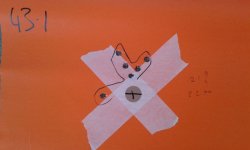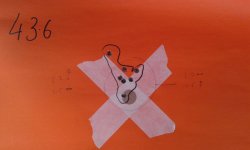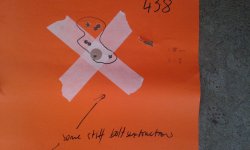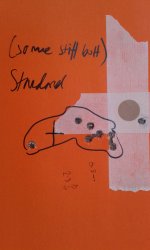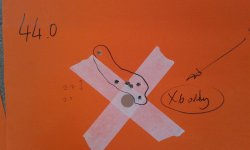Pond James Pond
New member
First the conditions. 300m was closed so I was not able to shoot there and had to make do with 100m instead. It was a warm day, lots of mirage, and a slight breeze.
So a recap of what this was all about. Basically I had access to some Brazilian mil-spec .308. I pulled a stack of them, measured the OAL and powder charge and then reassembled them. However, I reset the OAL to get me closer to the lands in my rifle. I also gave more homogeneity to the standard powder charge (43.8gn) as well as doing a little charge weight ladder starting at a weight 7.5% below the one above.
Given the number of cases I had I was able to do this with 7 shots per group. The charge weights came in at 42.6, 43.1, 43.6, 43.8 (the homogenised original) and 44. I also threw in 7 untouched rounds for comparison.
All were fired suppressed.
The results were on the one hand interesting yet on the other predictable. The predicatble side was that there was not some dramatic difference between the original cartridges and any of my home-tune jobs. The interesting thing was that at 43.8gn, 44gn and the untouched originals, I got some stiffer bolt turns. That to me suggests over-pressure of some kind.
Does 7.62 NATO have higher pressures than .308 Win as with 5.56 NATO and .223?
As a result I ditched the 7th 44gn cartridge.
For each group I measured MOA horizontally and vertically. They're listed in that order:
42.7gn: 1.6MOA/1.4MOA
43.1gn: 2.2MOA/2.1MOA (6 hits: one seemingly went straight through another bullet hit!!)
43.6gn: 1.5MOA/2.2MOA (drops to 1.0/1.5 if I ignore one outlier)
43.8gn: 1.7MOA/2.1MOA
44gn: 2.3MOA/2.7MOA (only six shots)
Original: 0.8MOA/2.8MOA



Of those, I'd have to discount the standards, 43.8 and 44gn due to sticky extraction, but 42.7gn looks promising. Amongst the smallest groups and also pretty uniform in shape. A call to a club member about the sticky extraction (he's shot them too) and it was suggested this might be because of slightly long cases from factory, perhaps due to the crimp? However, it still doesn't explain why it only happened at higher loads. Perhaps someone can clarify.
I can also say that shooting with a suppressor is way less tiring and recoil is indeed much less.
My take-home from this is that, whilst not ground-breaking, those rebuilt with 42.7gn of powder and a slightly longer OAL for my gun would definitely suit my needs from a practice round. They can also be reloaded, being boxer primed. This suddenly makes my .308 cheaper to shoot than my .38!!
A very informative outing.
So a recap of what this was all about. Basically I had access to some Brazilian mil-spec .308. I pulled a stack of them, measured the OAL and powder charge and then reassembled them. However, I reset the OAL to get me closer to the lands in my rifle. I also gave more homogeneity to the standard powder charge (43.8gn) as well as doing a little charge weight ladder starting at a weight 7.5% below the one above.
Given the number of cases I had I was able to do this with 7 shots per group. The charge weights came in at 42.6, 43.1, 43.6, 43.8 (the homogenised original) and 44. I also threw in 7 untouched rounds for comparison.
All were fired suppressed.
The results were on the one hand interesting yet on the other predictable. The predicatble side was that there was not some dramatic difference between the original cartridges and any of my home-tune jobs. The interesting thing was that at 43.8gn, 44gn and the untouched originals, I got some stiffer bolt turns. That to me suggests over-pressure of some kind.
Does 7.62 NATO have higher pressures than .308 Win as with 5.56 NATO and .223?
As a result I ditched the 7th 44gn cartridge.
For each group I measured MOA horizontally and vertically. They're listed in that order:
42.7gn: 1.6MOA/1.4MOA
43.1gn: 2.2MOA/2.1MOA (6 hits: one seemingly went straight through another bullet hit!!)
43.6gn: 1.5MOA/2.2MOA (drops to 1.0/1.5 if I ignore one outlier)
43.8gn: 1.7MOA/2.1MOA
44gn: 2.3MOA/2.7MOA (only six shots)
Original: 0.8MOA/2.8MOA
Of those, I'd have to discount the standards, 43.8 and 44gn due to sticky extraction, but 42.7gn looks promising. Amongst the smallest groups and also pretty uniform in shape. A call to a club member about the sticky extraction (he's shot them too) and it was suggested this might be because of slightly long cases from factory, perhaps due to the crimp? However, it still doesn't explain why it only happened at higher loads. Perhaps someone can clarify.
I can also say that shooting with a suppressor is way less tiring and recoil is indeed much less.
My take-home from this is that, whilst not ground-breaking, those rebuilt with 42.7gn of powder and a slightly longer OAL for my gun would definitely suit my needs from a practice round. They can also be reloaded, being boxer primed. This suddenly makes my .308 cheaper to shoot than my .38!!
A very informative outing.
Attachments
Last edited:


